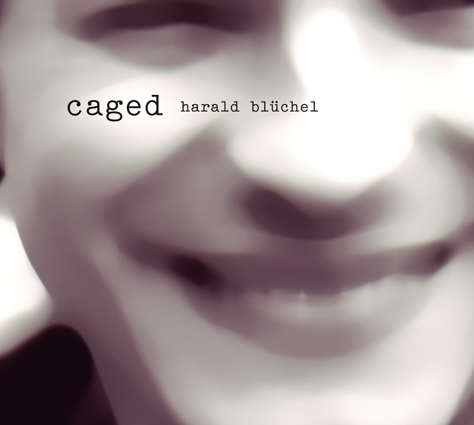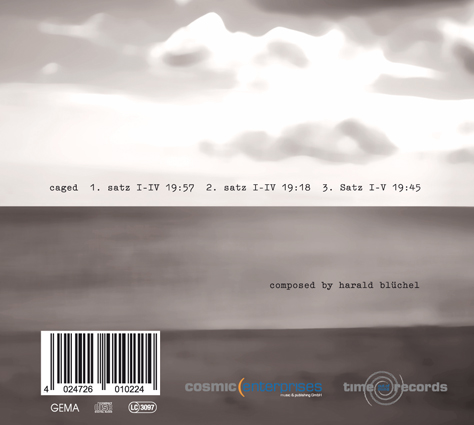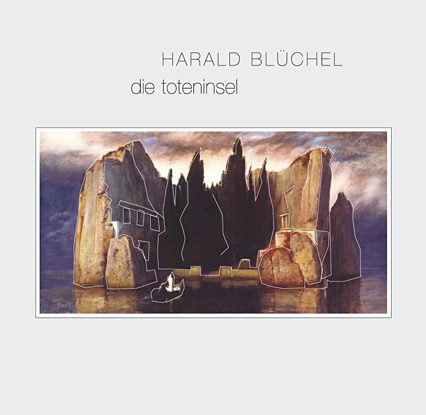

produced between Sept. 2001 & July 2002 | released on time out of mind records in April 2007 | Format: CD
1st Movement I-IV 15:00
2nd Movement I-IV 29:00
3rd Movement I-V 16:00
composed & produced by harald blüchel, sept.2001-June 2002
published by cosmic enterprises music & publishing GmbH
mastered by wolfgang ragwitz
graphics: rainer schleßelmann
TOOM 102, 2006
My Special thanks to Rolf Schlönvogt for his great cooperation.
NOTES:
I
Part one, „Die Toteninsel“, was a kind of a taking-stock for me:
– where am I now?
– what have I got at my disposal?
– where would I like to be?
– what do I need to go in this direction?
After completing the „Toteninsel“ I made a fundamental decision to put my own expectation of coming up with compositions that could be quickly prepared for release at the back of the line and to concentrate more on the aspect of research. In addition to experimenting, research means for me learning more than anything else. Studies of composition techniques, instruments and work with musicians with the goal of coming up with significant results together. My goal for each of the next projects is to establish a consistent, unambiguous language of forms which (in contrast to „Toteninsel“) I intend to construct with a strictly limited selection of instruments and production tools.
II
Between September 2001 and July 2002 I concentrated on a music project which I called “caged”. I was interested in the question:
How would the inner life, the soul, of a person
who “is no longer of this world” sound like?
At first, I wrote music for solo tenor and solo soprano saxophone, prepared piano, cello, violin and xylophone, that I then had played by musicians in the studio and recorded on to a hard drive.
In this process, I used the same composing technique John Cage used for his “number pieces”. The separate notes of the score must be played within a defined period whereby the musicians themselves can decide on the length of the notes and the technical interpretation of the score.
The important thing being to create an atmospheric expression during execution, the permanent tension between mind and body: for example, how does a saxophonist express suffering of the soul coupled with complete physical lethargy? Can a cello depict “suffocation” or what does a violinist do with a phrase captioned “crushed yearning”? The task demanded the greatest commitment and sensibility from the musicians as well as the will to go to the limits of their personal experiences and their musicianship.
In the next phase I took this abundant recorded material and began to combine separate particles cut from the “large score” using digital editing techniques. The independently recorded (“autistic”) micro-compositions (it was not intended that any of the musicians should be influenced by the interpretation of another when finding their own interpretation) were brought into contact, “reacted” with each other, were manipulated sometimes in a variety of ways and reformed until a body of sound in three movements resulted constituting the composition “caged”.
I consciously refrained from incorporating any explanatory dramaturgical elements such as text/language, identifiable environmental sounds or electronic synthesizers, which the listener might find “relaxing”, because it is precisely the reality of the specifically “unheard”, the internal condition of losing grip, which the piece intends to convey.
The end mix was done in September 2002.
Intellectual aspects: selected references and inspirations
I
Painting
Deodato di Orlandi: Trauernder Johannes (Lamenting John), last quarter 13th century
Albrecht Dürer: Selbstbildnis (Self-Portrait), around 1492
Johann Heinrich Füssli: Das Schweigen (The Silence), around 1788/1801
Caspar David Friedrich: Abtei im Eichwald (Cloister Graveyard in the Snow), 1809
Guillaume-BenjaminDuchenne: Persönliches Fotoalbum (Personal Photo Album),1855/56
Ron Mueck: Ohne Titel (no title), 2000
Igor & Svetlana Kopystiansky: Flow, 2002
Gerhard Richter: Tote (Dead Woman), 1988
II
Literature:
Alice Miller: Das Drama des begabten Kindes (The Drama of the gifted Child) (Suhrkamp, 1979)
Erich Fromm: Haben oder Sein (To Have or to Be?) (dtv, 1979)
Klaus Ottomeyer: Ökonomische Zwänge und menschliche Beziehungen (rororo, 1977)
Max Frisch: Stiller (Suhrkamp, 1958)
Heinrich Böll: Ansichten eines Clowns (The Clown) (dtv, 1967)
Ingeborg Bachmann: Malina (Suhrkamp, 1971)
Thomas Bernhard: Das Kalkwerk (The Lime Works) (Suhrkamp, 1973)
Helmut Krausser: Thanatos (Luchterhand, 1996)
Michel Houllebecq: Elementarteilchen (Atomised/The Elementary Particles)
(DuMont, 1999)
III
Music:
Ludwig van Beethoven: Klaviersonate No 31 As-dur op.110
Robert Schumann: Gesänge der Frühe op. 133
Gustav Mahler: Ich bin der Welt abhanden gekommen
György Ligeti: Lontano
Pink Floyd: The Wall
IV
Movies:
Andreij Tarkowskij: Der Spiegel (The Mirror), Stalker, Nostalghia
Louis Malle: Das Irrlicht
Jean-Pierre Melville: Der eiskalte Engel


